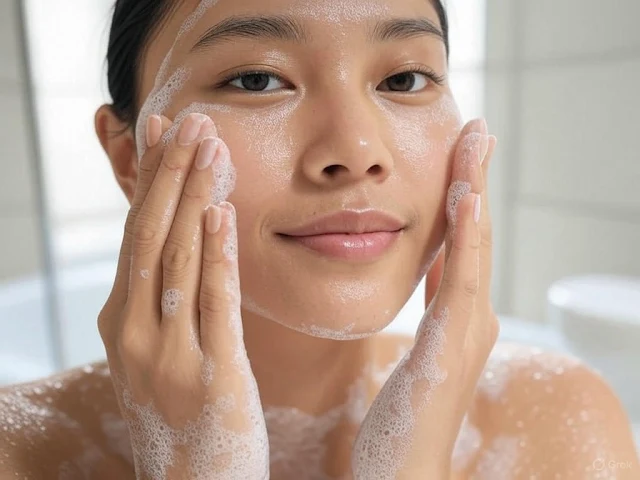Why Cleansing is the
First and Most Important Step
In
the realm of skincare, cleansing often gets overlooked as a mundane task, yet
it stands as the cornerstone of any effective routine. Whether you're a
skincare novice or a seasoned enthusiast, understanding why cleansing is the
first and most critical step can transform your approach to healthy, radiant
skin. This article explores the science, benefits, and practical reasons behind
prioritizing cleansing in your daily regimen.
The
Science Behind Cleansing
Your
skin is your body's largest organ, acting as a protective barrier against
environmental aggressors like pollution, UV rays, and bacteria. Throughout the
day, it accumulates impurities sweat, sebum, dead skin cells, makeup, and
airborne pollutants. These can clog pores, disrupt the skin's natural balance,
and accelerate aging if not removed properly.
Cleansing
removes these impurities, restoring the skin’s natural state and preparing it
for subsequent products like serums, moisturizers, or treatments. A clean
canvas ensures that active ingredients penetrate effectively, maximizing their
benefits. Without cleansing, even the most luxurious products may sit atop a
layer of grime, rendering them less effective or, worse, contributing to irritation.
Why
Cleansing Comes First
1.
Prevents Breakouts and Congestion
Clogged
pores are a primary cause of acne and blackheads. Excess oil and dead skin
cells create a breeding ground for bacteria, leading to inflammation and
breakouts. Regular cleansing, especially twice daily, keeps pores clear, reducing
the risk of blemishes and promoting a smoother complexion.
2.
Enhances Product Efficacy
Skincare
products are designed to penetrate the skin and deliver active ingredients like
hyaluronic acid, vitamin C, or retinol. However, a layer of dirt or oil can act
as a barrier, preventing absorption. Cleansing ensures that your skin is
receptive, allowing products to work as intended and delivering visible
results.
3.
Supports Skin Barrier Health
The
skin’s barrier, composed of lipids and cells, protects against moisture loss
and external irritants. Harsh environmental factors and improper cleansing can
weaken this barrier, leading to dryness, sensitivity, or irritation. A gentle,
pH-balanced cleanser removes impurities without stripping natural oils,
maintaining the barrier’s integrity.
4.
Combats Premature Aging
Pollutants
and free radicals from the environment can break down collagen and elastin, the
proteins responsible for the skin’s firmness and elasticity. Cleansing at the end
of the day removes these damaging agents, reducing oxidative stress and helping
to preserve a youthful appearance.
5.
Promotes Overall Skin Health
Beyond
aesthetics, cleansing supports the skin’s natural processes, such as cell
turnover and oil regulation. By keeping the skin clean, you create an
environment where it can function optimally, resulting in a balanced, glowing
complexion.
How
to Cleanse Effectively
To
reap the full benefits of cleansing, technique and product choice matter. Here are
some tips to elevate your cleansing routine:
·
Double Cleanse at Night: Start with an oil-based cleanser to
remove makeup, sunscreen, and excess oil, followed by a water-based cleanser to
deep-clean pores. This method ensures thorough removal of all impurities
without over-stripping the skin.
·
Use Lukewarm Water: Hot water can dehydrate the skin,
while cold water may not effectively dissolve oils. Lukewarm water strikes the
perfect balance.
·
Choose the Right Cleanser: Select a cleanser suited to your
skin type, gel for oily skin, cream for dry skin, or micellar water for sensitive
skin. Avoid harsh sulfates, which can disrupt the skin’s moisture barrier.
·
Don’t Overdo It: Over-cleansing can strip the skin
of essential oils, leading to irritation or excess oil production. Stick to
cleansing twice daily, in the morning and at night.
·
Pat, Don’t Rub: After cleansing, pat your skin dry
with a clean towel to avoid irritation. Follow immediately with a toner or
moisturizer to lock in hydration.
Common
Cleansing Mistakes to Avoid
While
cleansing is straightforward, common missteps can undermine its benefits:
·
Skipping Morning Cleansing: Even if you cleansed at night,
sweat and oil accumulate while you sleep. A gentle morning cleanse refreshes
the skin and preps it for daytime products.
·
Using Harsh Products: Cleansers with high alcohol content
or aggressive exfoliants can damage the skin barrier. Opt for gentle formulas
with hydrating ingredients like glycerin or ceramides.
·
Not Cleansing Long Enough: Spend at least 30–60 seconds
massaging your cleanser into the skin to ensure thorough cleansing. Rushing the
process may leave residue behind.
·
Ignoring Your Neck and Jawline: These areas are prone to oil
buildup and breakouts. Extend your cleansing routine below the chin for
comprehensive care.
Cleansing
as Self-Care
Beyond
its physical benefits, cleansing offers a moment of mindfulness in a busy day.
The act of massaging a cleanser into your skin, feeling the texture, and
rinsing away the day’s stress can be grounding. It’s a small ritual that
signals care for yourself, setting a positive tone for the rest of your
routine.
Conclusion
Cleansing
is more than a preliminary step; it’s the foundation of healthy, radiant skin.
By removing impurities, enhancing product efficacy, and supporting the skin’s
natural functions, it sets the stage for every other skincare step. Whether
you’re aiming to prevent breakouts, combat aging, or simply maintain a glowing
complexion, prioritizing cleansing is non-negotiable. So, grab a gentle
cleanser, take your time, and let this simple act transform your skin and your
routine for the better.
Disclaimer:
The information in this article is for educational purposes only and is not a
substitute for professional medical advice. Always consult a dermatologist or
qualified healthcare provider for personalized skincare recommendations,
especially if you have specific skin conditions or concerns. Product
suggestions are general and may not suit all skin types. Patch-test new
products to avoid adverse reactions.









Comments
Post a Comment